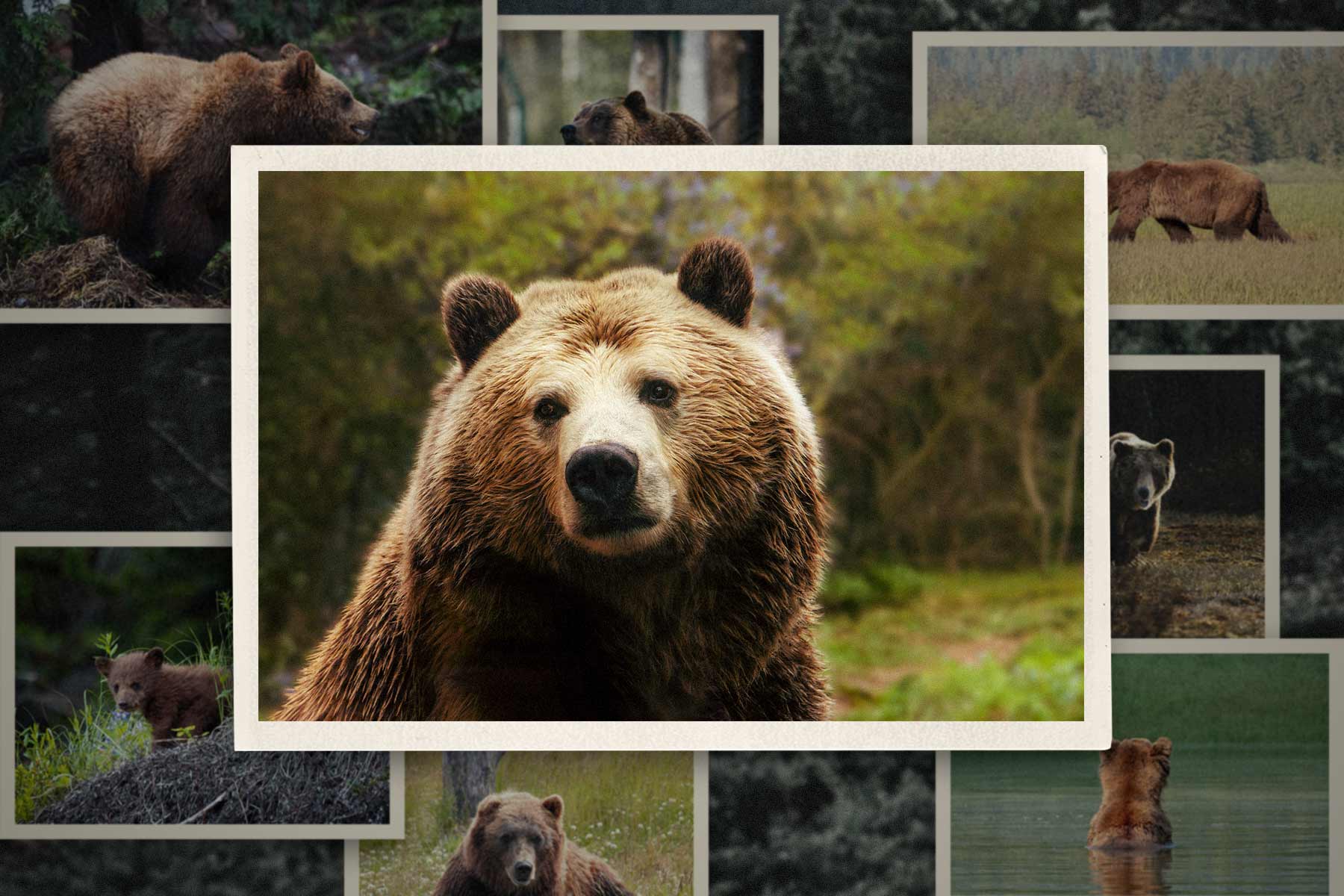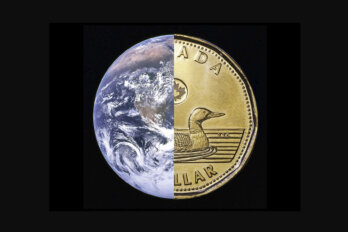It was late fall in the Canadian Rockies. Larches flickered along evergreen slopes, their blazes of orange soon to be snuffed out by the first big snow. The buffaloberry and chokecherry bushes lining the frothing edges of the Bow River had been picked clean. In the nearby mountain town of Banff, Alberta, crabapple trees bore ripening fruit. A precocious grizzly bear had been spotted among them, gorging on the harvest to prepare for the bitter cold. She would soon head into her winter den.
In Banff, I had met one of Parks Canada’s human–wildlife conflict and coexistence specialists who knew this particular bear well. Named Bear 148, the grizzly had been keeping him busy from sun-up to sundown. The town had an active grizzly bear warning in place. Playgrounds were closed, and signs were put up to warn of Bear 148’s presence. It was rare for Parks Canada to issue a warning for a bear persisting around town. But that day, as we set out from the specialist’s office, Bear 148 seemed to be retreating up Sulphur Mountain, near the hot springs where late-season tourists were soaking in pools.
Bear 148 wasn’t your typical grizzly. Her heritage had set her up for greatness in the Canadian Rockies. She was sired by Bear 122, a fearsome, upward-of-660-pounds grizzly nicknamed “The Boss.” He was a prolific breeder and a bully, earning a reputation for eating smaller black bears. He had reportedly been hit by a train—and survived. Bear 148’s mother was his opposite in almost every way. Nearly a decade older than her mate, Bear 64 was renowned for her gentle nature in the presence of people. She was a frontcountry bear who captivated wildlife photographers and vacationers as she foraged for roots and berries along the highway that runs through the heart of Banff National Park. Even when tourists moved too close, Bear 64 held back; she refrained from bluff-charging, instead giving an irritated huff.
But her daughter was proving difficult. With her impish ways and impervious determination, Bear 148 had landed on the special projects list of several Parks Canada specialists. That year—kicked away from her mom for the first time—the three-year-old bear hadn’t yet reached national acclaim, but she’d certainly made herself known to wildlife managers.
She was going through her rebellious teenage stage, the Parks Canada specialist half-joked as we drove up an old logging road that had been cleaved through a thicket of pine and Douglas fir. He estimated that he and his team had already chased Bear 148 away from Banff fifty times with an artillery of rubber bullets, bean bags, and shells, known as crackers and screamers, that exploded near her furry rump. “She’s got a bit of spunk in her step, for sure,” the specialist said. In what now seems sadly prescient, he noted: “She seems to be the bear we’re going to be most invested in, and certainly the bear we’ve been most invested in this year, and probably the bear we’ll be most invested in over the next few years, assuming she stays alive and can avoid the other hazards of living in Bow Valley.” Bear 148 had been fitted with a GPS collar a few months before my arrival, and Parks Canada staff relied on that collar to keep tabs on her. Inside the cab of the truck sat a powder-blue telemetry box, emitting a steady ping as we continued deeper into the forest.
The specialist fiddled with a few knobs to clarify the signal. Each bear in the park has its own distinctive frequency. Ping. Ping. Ping. Bear 148 was coming through loud and clear.
I scanned the conifer forest, hoping to see a blur of brown fur. Stillness. Spindly branches whacked the truck’s side mirrors with a rhythmic crackle as the specialist drove on up the mountain. Another ping caught his ear, stronger than before. “We’re within a couple kilometres of her now,” he said.
At a bend in the road, the Parks Canada specialist pulled out a directional antenna, used to pick up a bear’s precise whereabouts. Static danced from the radio. “I suspect she’s up on these slopes here,” he said, gesturing to a hill where the trees were sparse. Work crews had recently thinned the forest for fire safety and to allow more sunlight in. “It creates some really good buffaloberry habitat.”
We never got close enough to spot Bear 148, which pleased the specialist. The bear was moving away from town, up the mountain. With any luck, she would stay there for the winter. “As soon as she’s in an area like this, we completely back off,” he told me, putting the truck in reverse to get down the mountain.
After Alberta ended its trophy hunt for grizzly bears in 2006 to help the population recover, the bears’ numbers slowly began ticking up, reaching around 900 individuals in 2021. At the same time, more people were recreating in and living in the Canadian Rockies, with development splicing through bear country. But the story of Bear 148 extended beyond just the Rocky Mountain West. It served as a parable, I thought, for how humans and nature might coexist in an increasingly fragmented world.
In the years that followed, Bear 148’s circumstances didn’t improve. She once chased a woman kick-sledding on a trail in Banff, one Parks Canada officer told the CBC. Not long after, the bear was enjoying the sunny slopes of Mount Norquay ski hill when a group of hikers turned a corner and surprised her. The three hikers slowly backed away from the bear, but she followed them, and they began to run. In hopes of distracting the bear, the hikers unclipped their dog, Momo, from its leash. No one had brought bear spray.
When, in 2017, Bear 148 finally wandered down to Canmore, some 25 kilometres southeast of Banff, she moved beyond the reach of Banff National Park officials. She was instead dealing with provincial wildlife managers, who decided Bear 148’s time in Bow Valley had to come to an end.
Getting rid of Bear 148 wouldn’t be easy. Even with her uneasy temperament, the bear was beloved by Banff and Canmore residents. Euthanizing Bear 148 wasn’t yet an option. Instead, wildlife managers opted to relocate her. That summer, they trapped and tranquilized her, then drove her to the far western edge of her home range. They hoped that if—or when—Bear 148 returned to Bow Valley, it would be after Banff’s buffaloberry crop had ripened, with the bounty containing her to the park. But when Bear 148 awoke in her new surroundings, she walked the 40 kilometres back to Bow Valley within days.
Her return frustrated wildlife managers; it was an untenable situation to have a grizzly bear so close to a town of over 14,000 people. A helicopter was called in to translocate Bear 148 to just outside of Kakwa Wildland Provincial Park, a remote area more than 400 kilometres northwest of Banff and near the British Columbia border.
Bear 148 seemed to take a liking to this landscape. That or she couldn’t figure out how to return to Bow Valley. Grizzlies have a profound homing instinct, but it’s known to peter out at around 260 kilometres. Bear 148’s radio collar didn’t show her making a beeline for Banff like she had before. Rather, she stayed. She was nearly seven years old. That spring, she’d been seen mating with a male grizzly. If she could gain enough weight before winter arrived, she might soon have cubs of her own.
Bear 148 stayed around Kakwa for nearly two months, until, at some point in the late summer, she wandered over the border into BC and never came back.
On September 24, 2017, Bear 148 was shot and killed by a trophy hunter. One of Canada’s most famous and beloved bears would be one of the last grizzlies to be taken as a prize in BC. The province, home to some 15,000 grizzly bears, had still maintained a legal—if politically unpopular—grizzly trophy hunt. Every year, over 1,000 hunting licences were sold and around 250 grizzlies were shot and killed. But the debate over the hunt had reached a crescendo leading up to 2017, and the newly instated NDP government announced that they would ban all trophy hunting of grizzly bears. Licences for that fall’s hunt, however, had already been sold; many people were due to travel into the remote forests of the province to bag a bear. Officials decided November 30 would therefore mark the end of the hunt once and for all.
But it wouldn’t come soon enough for Bear 148. Banff’s beloved bear had successfully navigated the roads, train tracks, and ranches around Bow Valley. But she had never encountered a trophy hunter. In the end, it wasn’t the hazards of Bow Valley that would claim Bear 148’s life but a human with a gun who stared down a disoriented radio-collared bear and pulled the trigger.
Though three years had passed since my first near encounter with Bear 148, I had followed the young grizzly closely in the media. She seemed to me to embody a litmus test for human tolerance of bears. And her heartbreaking, and deeply ironic, demise singularly connected so many of the issues that bears face in the world today.
The story of Bear 148 is not the only one of its kind. For millennia, humans have nurtured a complex relationship with the bears of the world. We killed them and we shackled them—until, when they were on the brink of extinction, we reversed course, choosing to conserve our ursine neighbours instead of conquering them. We wrote bears into folktales as fuzzy clowns of the forest, a kinder portrayal that allowed us to champion their survival. But this has often meant restoring the animals, like Bear 148, to a manufactured landscape that is no longer meant for them.
In Canada’s Bow Valley, highways and train tracks fragment pine forests, funnelling bears toward their death. Grizzlies have long targeted railway tracks for foraging, and many have met their demise on the country’s key transportation corridors. At the same time, Canmore’s population has grown by nearly 15 percent since 2016—outpacing both the provincial and Canadian average. And as the Alberta grizzly population has steadily increased, the bruins are straying into the prairies, where people struggle to adjust to their presence. Provincial authorities, for example, had killed Bear 148’s brother two years before her own death, after he was caught preying on a llama ranch near Sundre, Alberta.
As bears regain ground, our relationship to the charismatic king of the wilderness remains fraught. Restoring butterflies and beavers to meadows and wetlands is child’s play compared with bringing back an apex predator capable of killing hikers and hunters. Bears require huge amounts of land, and people must alter their behaviour in bear country, acquiescing to another monarch.
Today, bears around the world are in trouble. Six of the world’s eight remaining bear species are facing threat of extinction, according to the International Union for Conservation of Nature. And only the American black bear is considered secure throughout its range. If we fail to make room for bears, we will solidify a future where many of the world’s bears exist only behind glass. Losing bears would mean we lose a beautiful and complex relationship that has paralleled our own journey in this world. And in some ways, we would lose a part of our own wildness. Without bears, the woods—and so many of our stories—would be empty.





